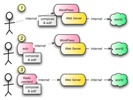To help conceptualize where the “rubber meets the road” when it comes to creating your blog – and help you sort out the blogging tools that I’ve been discussing in the last few posts, I put together some diagrams.
These diagrams and their explanations may help you understand the three methods I’ve been discussing for posting to your blog…
Method 1) Creating your posts online and using blog software on the server:
Most bloggers today are posting directly to their blog software thru a web browser. They’re connected to the Internet and they’re online the whole time they’re working on a blog entry. Technically the software on the server’s called a web application. I’ve used WordPress, Movable Type and Blogger, and will use WP in my example, but of course you may use any online blog software. And it could be hosted by a “free” service, like WordPress.com, or it could be on your own server. Or it could be embedded in myspace or other services that include far more than just blogs. No matter which blog software’s in use, you can interact directly with it, usually using a WYSIWYG visual editor and the posts are immediately available for readers. WordPress is installed on the same computer as the web server software.
Method 2) Creating and editing posts offline and uploading to blog software on the server:
Products like ecto and MarsEdit allow you to create and edit your posts offline, including manipulating graphics and photos while you’re offline. Then when you go online, the posts are uploaded to WordPress using a standardized “interface” (XML Remote Procedure Calls in the case of WordPress), and then become available just as if they had been created online. WordPress is installed on the same computer as the web server software.
Method 3) Creating and editing everything offline and then uploading to a web server:
Products like Radio Userland and Apple’s iWeb allow you to create and edit posts offline and they they generate HTML pages that can be uploaded to a web server. No other software is required on the web server, though in the case of Radio, a hosted service is provided for one year as part of the price of the package, and iWeb can post to Apple’s dot-mac (“.mac”) service if you have an account. [Footnote: Userland’s Manila product is comparable to the hosted WordPress and other such service.]




Leave a Reply